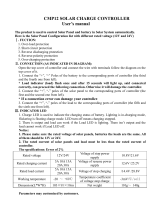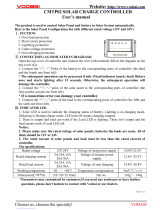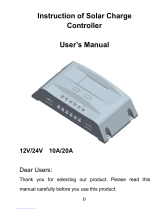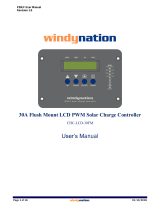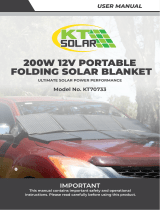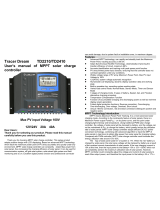Page is loading ...

The Traveler Series
TM
: Adventurer
30A PWM
Flush Mount Charge Controller w/ LCD Display
2775 E. Philadelphia St., Ontario, CA 91761
1-800-330-8678
Version 4.1

1
Important Safety Instructions
Please save these instructions.
This manual contains important safety, installation, and operating instructions for the charge
controller. The following symbols are used throughout the manual:
WARNING: Indicates a potentially dangerous condition. Use extreme caution when
performing this task.
CAUTION: Indicates a critical procedure for safe and proper operation of the controller
NOTE: Indicates a procedure or function that is important to the safe and proper operation
of the controller.
General Safety Information
• Read all of the instructions and cautions in the manual before beginning the installation.
• There are no serviceable parts for this controller. Do NOT disassemble or attempt to repair
the controller.
• Make sure all connections going into and from the controller are tight. There may be sparks
when making connections, therefore, make sure there are not flammable materials or
gases near installation.
Charge Controller Safety
• NEVER connect the solar panel array to the controller without a battery. Battery must be
connected first. This may cause a dangerous occurrence where the controller would
experience a high open circuit voltage at the terminals.
• Ensure input voltage does not exceed 50 VDC to prevent permanent damage. Use the
Open Circuit (V
oc
) to make sure the voltage does not exceed this value when connecting
panels together in series.
• The charge controller should be installed indoors in a well-ventilated, cool, and dry
environment.
• Do NOT allow water to enter the controller.
Battery Safety
• Do NOT let the positive (+) and negative (-) terminals of the battery touch each other.
• Use only sealed lead-acid, flooded, or gel batteries which must be deep cycle.
• Explosive battery gases may be present while charging. Be certain there is enough
ventilation to release the gases.

2
• Be careful when working with large lead acid batteries. Wear eye protection and have
fresh water available in case there is contact with the battery acid.
• Over-charging and excessive gas precipitation may damage the battery plates and
activate material shedding on them. Too high of an equalizing charge or too long of one
may cause damage. Please carefully review the specific requirements of the battery used
in the system.
WARNING: Connect battery terminals to the charge controller BEFORE connecting the solar
panel(s) to the charge controller. NEVER connect solar panels to charge controller until the battery
is connected.

3
Table of Contents
General Information ...................................................................................................... 4
Included Components ................................................................................................... 6
Identification of Parts .................................................................................................... 7
Installation ..................................................................................................................... 8
Mounting Recommendations: .................................................................................. 8
Flush Mounting: ......................................................................................................... 9
Surface Mount Attachment ..................................................................................... 10
Wiring ....................................................................................................................... 10
Operation ..................................................................................................................... 14
Change the Parameters ........................................................................................... 15
1. Power Generation Interface Reset ................................................................. 15
2. Battery Interface Set Battery Type ................................................................. 15
3. Battery Temperature Interface Change from C° to F° .................................. 15
System Status Icons ................................................................................................... 16
System Status Troubleshooting ................................................................................ 16
Maintenance ................................................................................................................ 17
Fusing .......................................................................................................................... 17
Technical Specifications ............................................................................................ 18
Battery Charging Parameters ................................................................................. 18
Dimensions .................................................................................................................. 19

4
General Information
The Adventurer is an advanced charge controller for off-grid solar applications. Integrating highly
efficient PWM charging, this controller increases battery life and improved system performance.
It can be used for 12V or 24V battery or battery bank. The controller is embedded with self-
diagnostics and electronic protection functions that prevent damages from installation mistakes
or system faults.
Key Features
• Automatic recognition for 12V or 24V system voltage
• 30A charging capacity
• Backlit LCD screen for displaying system operating information and data.
• Full control of parameter settings that can be adjusted.
• Deep Cycle Sealed, Gel, and Flooded battery option.
• 4 Stage PWM charging: Bulk, Boost. Float, and Equalization
• Temperature compensation and correcting the charging and discharging parameters
automatically, improving battery lifetime.
• Protection against: overcharging, over current, short-circuit, and reverse polarity.
• Unique USB port on the front display
• Specifically designed for RV application and allows for aesthetically clean flush mounting
on walls
• Remote temperature compensation compatible
• Remote battery voltage sensor compatible
PWM Technology
The Adventurer utilizes Pulse Width Modulation (PWM) technology for battery charging. Battery
charging is a current based process so controlling the current will control the battery voltage. For
the most accurate return of capacity, and for the prevention of excessive gassing pressure, the
battery is required to be controlled by specified voltage regulation set points for Absorption, Float,
and Equalization charging stages. The charge controller uses automatic duty cycle conversion,
creating pulses of current to charge the battery. The duty cycle is proportional to the difference
between the sensed battery voltage and the specified voltage regulation set point. Once the
battery reached the specified voltage range, pulse current charging mode allows the battery to
react and allows for an acceptable rate of charge for the battery level
Four Charging Stages
The Adventurer has a 4-stage battery charging algorithm for a rapid, efficient, and safe battery
charging. They include: Bulk Charge, Boost Charge, Float Charge, and Equalization.

5
Bulk Charge: This algorithm is used for day to day charging. It uses 100% of available solar
power to recharge the battery and is equivalent to constant current.
Boost Charge: When the battery has charged to the Boost voltage set-point, it undergoes an
absorption stage which is equivalent to constant voltage regulation to prevent heating and
excessive gassing in the battery. The Boost time is 120 minutes.
Float Charge: After Boost Charge, the controller will reduce the battery voltage to a float
voltage set point. Once the battery is fully charged, there will be no more chemical reactions and
all the charge current would turn into heat or gas. Because of this, the charge controller will reduce
the voltage charge to smaller quantity, while lightly charging the battery. The purpose for this is
to offset the power consumption while maintaining a full battery storage capacity. In the event that
a load drawn from the battery exceeds the charge current, the controller will no longer be able to
maintain the battery to a Float set point and the controller will end the float charge stage and refer
back to bulk charging.
Equalization: Is carried out every 28 days of the month. It is intentional overcharging of the
battery for a controlled period of time. Certain types of batteries benefit from periodic equalizing
charge, which can stir the electrolyte, balance battery voltage and complete chemical reaction.
Equalizing charge increases the battery voltage, higher than the standard complement voltage,
which gasifies the battery electrolyte.
WARNING: Once equalization is active in the battery charging, it will not exit this stage unless
there is adequate charging current from the solar panel. There should be NO load on the batteries
when in equalization charging stage.
WARNING: Over-charging and excessive gas precipitation may damage the battery plates and
activate material shedding on them. Too high of equalizing charge or for too long may cause
damage. Please carefully review the specific requirements of the battery used in the system.

6
Included Components
Remote Temperature Sensor (TS-R)
Measures the temperature at the battery and uses this data for
very accurate temperature compensation. The sensor is
supplied with a 6.6ft cable length that connects to the charge
controller.
NOTE: The Adventurer comes equipped with a temperature
sensor, but it is ONLY for the charge controller’s temperature
compensation, not the battery’s temperature compensation.
Remote Battery Voltage Sensor (RBVS)
Measures battery voltage accurately. The voltage detected at
the battery terminals on the controller may differ from the real
battery voltage due to the connection and cable resistance.
Therefore, this sensor, though not required, is recommended
for best performance.
Adventurer Surface Mount Attachment
The Renogy Adventurer Surface Mount will give you the option
to mount the charge controller to any flat surface; circumventing
the flush mount option.
NOTE: Screws included for the attachment
NOTE: Screws are included for flush mounting.

7
Identification of Parts
Key Parts
1. USB Port
2. Select Button
3. Enter Button
4. Liquid Crystal Display (LCD)
5. PV terminals
6. Battery Terminals
7. Remote Temperature Sensor Terminal (optional accessory)
8. Remote Battery Voltage Sensor Terminal (optional accessory)
8
7
7
5
6
2
3
4
1

8
Installation
WARNING: Connect battery terminal wires to the charge controller FIRST then connect the solar
panel(s) to the charge controller. NEVER connect solar panel to charge controller before the battery.
CAUTION: Do not over-torque or over tighten the screw terminals. This could potentially break
the piece that holds the wire to the charge controller.
CAUTION: Refer to the technical specifications for max wire sizes on the controller and for the
maximum amperage going through wires.
Mounting Recommendations:
WARNING: Never install the controller in a sealed enclosure with flooded batteries. Gas can
accumulate and there is a risk of explosion.
The Adventurer is designed for flush mounting on a wall. It consists of a face plate with projecting
terminals on the backside for connecting the battery bank, panels, and optional sensors for
accurate battery voltage sensing and battery temperature compensation. If utilizing the wall
mount, then the wall will be required to be cut to accommodate the projecting terminals on the
backside. Make sure that the pocket of the wall cut leaves enough space to not damage the
terminals when the Adventurer is being pushed back into the cut out section of the wall.
The front of the Adventurer will serve as a heat sink, therefore it is important to ensure that the
mounting location is not near any heat generating sources and ensure that there is proper airflow
across the faceplate of the Adventurer to remove the heat dissipated from the surface.
1. Choose Mounting Location—place the controller on a vertical surface protected from
direct sunlight, high temperatures, and water. Make sure there is good ventilation.
2. Check for Clearance—verify that there is sufficient room to run wires, as well as
clearance above and below the controller for ventilation. The clearance should be at least
6 inches (150mm).
3. Cut out Wall section—the recommended wall size to be cut should follow the inner
protruding part of the charge controller while being careful not to go past the mounting
holes. The depth should be at least 1.7 inches (43mm).
4. Mark Holes
5. Drill Holes
NOTE: The Adventurer comes equipped with screws for wall mounting. If they are not
suitable try using Pan Head Phillips Screw 18-8 Stainless Steel M3.9 Size 25mm
length screws.
6. Secure the charge controller.

9
Flush Mounting:

10
Surface Mount Attachment:
The charge controller can also be mounted on a flat surface using the Adventurer Surface
Mount Attachment. In order to properly mount the charge controller, steps 1 and 2 for the flush
mount option can be followed. However, there is no need to cut a section of the wall considering
the charge controller can now be mounted on a flat surface using the attachment. Mark and drill
holes using the four pan head Phillips screws that are provided specifically for the surface
mount option.
Wiring
1. Unscrew battery terminals and connect battery connections

11
2. Unscrew PV terminals and connect PV connections

12
3. Insert Temeprature Sensor block terminal and connect wires
(POLARITY SENSITIVITY DOES NOT MATTER)

13
4. Insert Battery Voltage Sensor block terminal and connect wires
(POLARITY SENSITIVE)
WARNING: If unscrewing the wires from the Temperature Sensor Block and Battery
Voltage Sensor Block, make sure to not mix up the wires and terminal blocks. Doing
so will result in irreversible charge controller damage.

14
Operation
After connecting the battery to the charge controller, the controller will turn on automatically.
Assuming normal operation, the charge controller will cycle through different display. They are as
follows:
Parameter
Display
PV Array Voltage
PV 0.0
V
Charging Current
PV 0.0
A
Generated Energy
PV 0.0
kWh
Battery Voltage
BATT 0.0
V
Temperature
BATT 0.0
F°
The Adventurer is an easy to use controller requiring minimal maintenance. The user is able to
adjust some parameters based on the display screen. The user can manually cycle through the
display screens by using the “SELECT” and “ENTER” buttons
SELECT
Cycles forwards through the different display screens.
ENTER
Cycles backwards through the different select screens
&
Customize some parameters on the charge controller

15
Change the Parameters
Simply hold the “ENTER” button for approximately 5 seconds until the display flashes. Once
flashing, then press “SELECT” until the desired parameter is reached and press “ENTER” one
more time to lock in the parameter.
NOTE: The screen must be at the appropriate interface in order to change the specific
parameter.
1. Power Generation Interface Reset
The user is able to reset the current power generation (kWh) back to 0 kWh.
2. Battery Interface Set Battery Type
In this interface, the user is able to select which type of battery is connected to the charge
controller. Choose from Sealed, Gel, or Flooded batteries.
3. Battery Temperature Interface Change from C° to F°
The user can select between displaying battery temperature in Celsius or Fahrenheit.

16
System Status Icons
Icon
Behavior
Constant: System is normal, but it is not charging
Charging: The bars will be sequencing indicating the system is
charging.
Constant: The battery is at full charge.
Flashing: The battery is overvoltage.
Flashing: The battery is under voltage.
System Status Troubleshooting
Indicator
Description
Troubleshoot
Flashing
Battery over
voltage
Use a multi-meter to check the voltage of the battery. Make
sure the battery voltage is not exceeding the rated
specification of the charge controller. Disconnect battery.
Flashing
Battery under
voltage
Use a multi-meter to verify the rated battery voltage.
Disconnect any loads connected to the battery to allow it to
charge.
Other Considerations
Charge controller does not
charge during daytime when
the sun is shining on the
solar panels.
Confirm that there is a tight and correct connection from the
battery bank to the charge controller and the solar panels to
the charge controller. Use a multi-meter to check if the polarity
of the solar modules have been reversed on the charge
controller’s solar terminals.
Everything is connected
correctly, but the LCD on the
controller does not turn on
Check the rated battery voltage. The LCD will not display on
the charge controller unless there is at least 9V coming from
the battery bank.

17
Maintenance
For best controller performance, it is recommended that these tasks be performed from time to
time.
1. Check that controller is mounted in a clean, dry, and ventilated area.
2. Check wiring going into the charge controller and make sure there is no wire damage or
wear.
3. Tighten all terminals and inspect any loose, broken, or burnt up connections
Fusing
Fusing is a recommendation in PV systems to provide a safety measure for connections going
from panel to controller and controller to battery. Remember to always use the recommended
wire gauge size based on the PV system and the controller.
NEC Maximum Current for different Copper Wire Sizes
AWG
16
14
12
10
8
6
4
2
0
Max.
Current
10A
15A
20A
30A
55A
75A
95A
130A
170A
Fuse from Controller to Battery
Controller to Battery Fuse = Current Rating of Charge Controller
Ex. Adventurer = 30A fuse from Controller to Battery
Fuse from Solar Panel(s) to Controller
Ex. 200W; 2 X 100 W panels
Parallel
Total Amperage = I
sc1
+ I
sc2
= 5.75A + 5.75A * 1.56
Fuse = minimum of 11.5 * 1.56 = 17.94 = 18A fuse

18
Technical Specifications
Description
Parameter
Nominal Voltage
12V / 24V Auto Recognition
Rated Charge Current
30A
Max. PV Input Voltage
50 VDC
Max. Wattage Input
400W (12V), 800W (24V)
USB Output
5V, 2.4A max
Equalization Voltage
Sealed: 14.6 V; Gel: None; Flooded: 14.8 V
(x2 / 24V)
Boost Voltage
Sealed: 14.4 V; Gel: 14.2 V; Flooded: 14.6 V
(x2 / 24V)
Float Voltage
13.8V (x2 / 24V)
Under Voltage
12V / 24V
Self-consumption
≤13mA
Temperature
Compensation Coefficient
-3mV/℃/2V
Operating Temperature
-25℃ to +55℃ | -13
o
F to 131
o
F
Storage Temperature
-35℃ to +80℃ | -31
o
F to 176
o
F
Enclosure
IP20
Terminals
Up to #4 AWG
Weight
0.6 lbs.
Battery Charging Parameters
All the coefficient is referred to 25℃, and twice in 24V system rate.
Battery
GEL
SEALED
FLOODED
High Voltage
Disconnect
16 V
16 V
16 V
Charging Limit
Voltage
15.5 V
15.5 V
15.5 V
Over Voltage
Reconnect
15 V
15 V
15 V
Equalization Voltage
-----
14.6 V
14.8 V
Boost Voltage
14.2 V
14.4 V
14.6 V
Float Voltage
13.8 V
13.8 V
13.2 V
Boost Return Voltage
13.2 V
13.2 V
13.2 V
Low Voltage
Reconnect
12.6 V
12.6 V
12.6 V
Under Voltage
Recover
12.2 V
12.2 V
12.2 V

19
Under Voltage
Warning
12 V
12 V
12 V
Low Voltage
Disconnect
11.1 V
11.1 V
11.1 V
Discharging Limit
Voltage
10.8 V
10.8 V
10.8 V
Equalization Duration
-----
2 hours
2 hours
Boost Duration
2 hours
2 hours
2 hours
Dimensions
Adventurer
/
